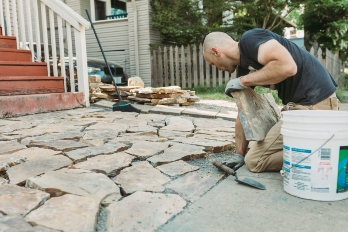Did you know that the interest you pay on your mortgage can double the cost of your home? It seems shocking, but think about it: you’re paying 30 years’ worth of interest on a six-figure loan. No wonder it’s so hard to afford a place of your own.
But there’s a simple way to take a machete to that massive pile of interest and potentially put tens of thousands of dollars back in your pocket. Just make modest but regular extra payments toward what you borrowed (the principal), especially in the early years of homeownership.
We know what you’re thinking: “Pay even more every month?” But wait until you see the math! You’ll build equity and own your home free and clear faster, of course. But what’s really impressive is how much you get back in interest. Every extra payment on principal is like making an investment with a guaranteed return.
Read on, and we’ll explain how it works and show you how making payments on principal can easily double your money. The key thing to understand is your loan’s amortization schedule.
Why is the amortization schedule important?
Mortgage loans are amortized. All that means is that the payments are spread out over a set period of time. Most homebuyers opt for a 30-year term, but 15- and 20-year terms are common too. (Whatever the term, most mortgage loans don’t have a penalty for early payoff, but double-check before you sign!)
An amortization schedule shows every single mortgage payment you’ve agreed to make, broken out into principal and interest. It also shows the total interest you will have paid at that point, and how much you’ll still owe on the loan. It’s important because it gives you a very clear picture of how much you’re really paying for your home.
If you didn’t get your amortization schedule at the closing, ask your servicer to generate it for you, or use an amortization calculator to estimate.
Here are a few lines from the amortization schedule for a 30-year, $200,000 loan at a fixed rate of 4.5 percent. As the top line shows, when you first start paying off this mortgage, most of your monthly payment goes toward interest. You’re barely making a dent in the principal of your loan.
Leaping forward 30 years, to the bottom of the schedule … By the time you make your final payment, you’ve paid nearly $165,000 in interest!
Remember, this is for an interest rate of 4.5 percent. If your rate were higher, you would pay even more.
Why do extra payments pay back more at the beginning?
As we saw above, in the early years of a mortgage, most of your payment is going toward interest. When you kill off a chunk of principal with extra payments in the first year, that’s more than 29 years’ worth of interest you won’t be handing over to the bank for that chunk. If you do it in year 20, you’re saving yourself only 10 years’ worth of interest.
So the key to getting the most out of extra payments is to make them early — year five is better than year seven, January is better than December. But the really important thing is just to do it.
Which brings us to the other key: consistency, especially with small payments. Paying $100 extra once in a while won’t do a lot, but paying it every single month, year in, year out, will make a major difference.
Let’s look at the math. To see for yourself, using your own numbers, try out the amortization calculator we used. (Click on “Show amortization schedule” to see the whole thing, and on “Add extra payments” to explore different scenarios.)
$100 a month saves $32,000 and pays off the loan 5 years early
Really! Again, we’re looking at a 30-year, $200,000 loan with a fixed rate of 4.5 percent and a monthly payment of $1,000 and change (not including property taxes or insurance).
- Total interest if you pay the minimum: nearly $165,000
- Total interest if you pay an extra $100 a month: $133,000
- Interest saved: $32,000
- Payoff date: 5 years early
Here’s how to find $100 a month hiding in your everyday spending.
Now add $500 from your tax refund every year
Most Americans get some sort of tax refund every year. So let’s say you pay $100 extra every month plus $500 once a year when you get your tax refund.
- Total interest if you pay the minimum: nearly $165,000
- Total interest if you pay the $100 a month plus $500 annually: $123,000
- Interest saved: $42,000
- Payoff date: More than 6.5 years early!
How about turning $5,000 into $13,000?
Let’s say you get hold of an extra $5,000. Maybe from an unexpected bonus at work. You could take a fancy European vacation. Or you could show your future self some love!
- Apply it to your principal one year into your loan, and you’ll save $13,000 in interest and pay off your home 1.5 years early
- Apply it 10 years into your loan, and you’ll save $7,000 in interest and slice almost six months off your loan
Bonus: You’ll get a “raise” when you get rid of PMI faster too
Most first-time homebuyers don’t have a 20 percent down payment (and it’s a myth that you need one). That means paying private mortgage insurance (PMI) every month. When you make extra payments on principal, you’re building toward that 20 percent in equity faster. And when you get there, you’ll be able to get rid of your PMI, which amounts to getting a little raise.
As you can see, even if you don’t stay in your home forever, payments on principal can pay off. At the very least, if you sell, you’ll get to keep more of the purchase price thanks to the additional equity you will have built up.
How do you make extra payments?
Some loan servicers will automatically put anything beyond your regular payment toward principal. But some won’t. Your extra payment could end up going toward next month’s payment. If your servicer hasn’t provided a clear way to indicate how you want extra payments applied, contact them first. Then, every month, check your mortgage statement to make sure your extra payment did come off the principal.
Setting up automatic payments is a great idea. Discipline is so much easier when you leave yourself out of it!
Check out EarnUp. Their stress-busting debt-management service automates all your loan payments to help you get out of debt faster. Automation helps ensure that you avoid late fees, but more importantly, EarnUp helps you make the most of payments on principal. So, just like we’ve been talking about, by the time you pay off your loans, you will have saved a lot of money on interest.
Why not just get a loan with a shorter term?
That’s definitely an option. Loans with 15- or 20-year terms have lower interest rates too, so they’re great if the higher monthly payment is comfortable for you. But if it’s a stretch, why stress yourself out?
When you take out a 30-year loan and make extra payments on principal, you won’t get the lower interest rate, but you can still pay off your home early and save a ton on interest — without being legally bound to the larger monthly payment.
Using an amortization calculator, you can figure out how much you need to pay each month to pay off your mortgage in 15 years, 20 years — whatever your goal is. But if money gets tight at some point, you can fall back to your official mortgage payment.
What’s better, making extra payments or investing?
That’s a tough question. When you make extra payments on principal, you’re guaranteed to save money on interest, possibly a lot of money, and you won’t pay taxes on that savings. That can easily make for a better “investment” than, say, the stock market. There’s also the fact that paying off your house early amounts to a jump in income, which will be especially welcome if you’re nearing retirement!
Still, from a strictly dollars and cents perspective, extra payments on principal aren’t always the best use of extra money. Predicting the rate of return on a given investment can be tricky. If you’re considering another investment and aren’t sure what to do, consider getting some advice from a good financial planner.
This is a good time to note that you shouldn’t make extra payments on principal at the expense of building an emergency fund. If your finances ever take a turn for the worse, that fund could keep you out of foreclosure.




